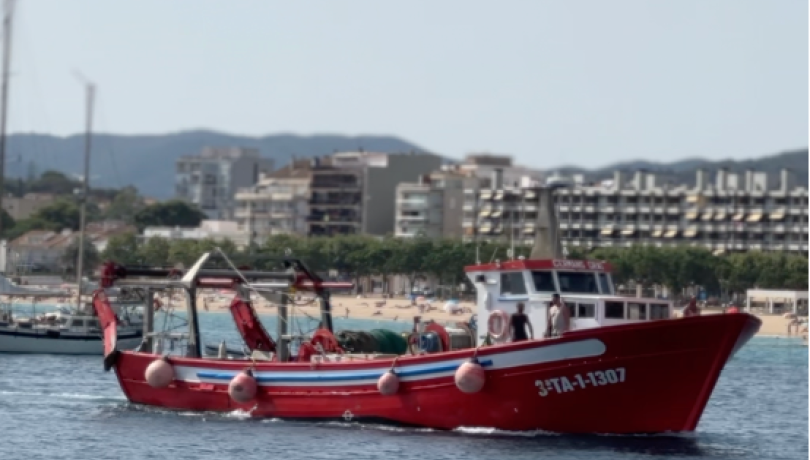A team from the ICM CSIC has verified that its overfishing index is 25% lower than that of the rest of the red shrimp fisheries on the Catalan coast.

The Palamós red shrimp (Aristeus antennatus) trawl fishery is currently the best managed fishery in Catalonia, with an overfishing index 25% lower than that of the rest of the red shrimp fisheries on the Catalan coast and 18% lower than the overfishing index of the northwestern Mediterranean, where, apart from red shrimp, the most exploited species include hake (Merluccius merluccius) and Norway lobster (Nephrops norvegicus).
All this information has been collected thanks to the ARISTOCK project, an initiative led by the Institut de Ciències del Mar (ICM-CSIC), which has made it possible to determine the state of the red shrimp stock in Palamós in comparison with the stock along the entire Catalan coast. The project has also led to the implementation, by the Palamós Fishermen's Guild, of exceptional and pioneering co-management measures that have allowed the fishery, which reached its critical point in 2005, to recover faster than other fisheries along the Catalan coast.
"We have been collaborating with Palamós fishermen for more than a decade through bilateral and continuous knowledge transfer. The co-management measures applied so far seek to increase the sustainability of the fishery. We study their effects and communicate them to the fishermen to adjust these actions", explains Juliana Quevedo, one of the ICM-CSIC researchers involved in the project.
15 years ago given the delicate situation of the red shrimp in the western Mediterranean, the Palamós fishermen's association began to implement measures for its recovery, first voluntarily and then officially. These include improving the selectivity of trawl nets, which since 2017 operate with a 50 mm square mesh size, which reduces the capture of small and immature individuals and favours that these individuals reach sexual maturity and can reproduce.
Likewise, starting in 2019, semi-pelagic doors began to be used in trawls. Unlike the demersal doors previously used, semi-pelagic doors do not touch the bottom during fishing, which avoids the resuspension of the sediment. This reduced disturbance of the seabed favours demersal species and various ecosystem services.
On the other hand, starting in 2013, fishing effort was reduced from 12 to 11 hours per day, and the engine power of the boats was limited to a maximum of 500 hp. In addition, in Palamós the fleet of boats has been reduced from 22 to 16 since 2018 and a closed season of 60 days per year has been implemented. All these management measures have been adopted voluntarily -which is not the case in any other Mediterranean fishery- and represent small steps towards the declaration of sustainability of the Palamós shrimp fishery.
In this regard, in 2017 an action plan was defined, within the framework of the Medfish project led by the Marine Stewardship Council (MSC) and WWF, to address all the areas of improvement identified in the fishery towards the MSC Fisheries Standard. This plan has served as a roadmap to move toward possible certification under the MSC program. If achieved, the Palamós red shrimp would become the first demersal - or bottom trawl - fishery to obtain this certification in the Mediterranean.
"All these efforts imply a change of trend towards a sustainable exploitation of the resource and, therefore, towards the recovery of the fishery and the socio-economy linked to the management of red shrimp," says Pablo Couve, another ICM-CSIC researcher involved in the project.
All in all, the ICM-CSIC, through the ARISTOCK project has managed to provide very valuable information for all the agents involved in the Palamós red shrimp fishery, thus contributing to advance towards the environmental sustainability levels established by the MSC, an international organization that has the most internationally recognized sustainable fishing certification program.
This year, it is planned to update the action plan defined in 2017 and establish the implementation schedule of measures needed to move towards sustainability certification of the Palamós red shrimp fishery. This will include the development of a new project that will evaluate the different current management strategies and simulate the most likely sustainable fishing scenarios. "In turn, the project will allow us to evaluate the consequences of the different scenarios and the various management options for the resource," said the principal investigators of the project, Nixon Bahamón and Joan B. Company, also from the ICM-CSIC.
Finally, the head of Mediterranean Fisheries for MSC Spain, Julio Agujetas, concludes: "the results of the ARISTOCK project show the effort of fishermen, scientists, administrations and NGOs to achieve an effective management for the Palamós red shrimp fishery that guarantees its sustainability and allows it to continue advancing towards the levels established by the MSC Fisheries Standard".